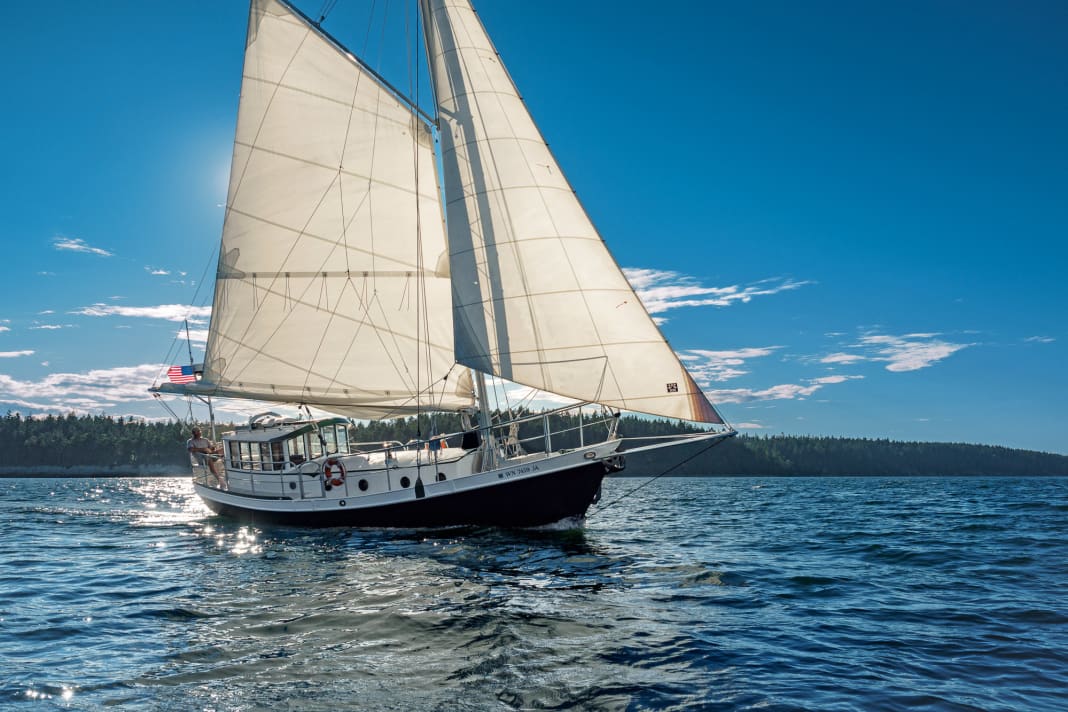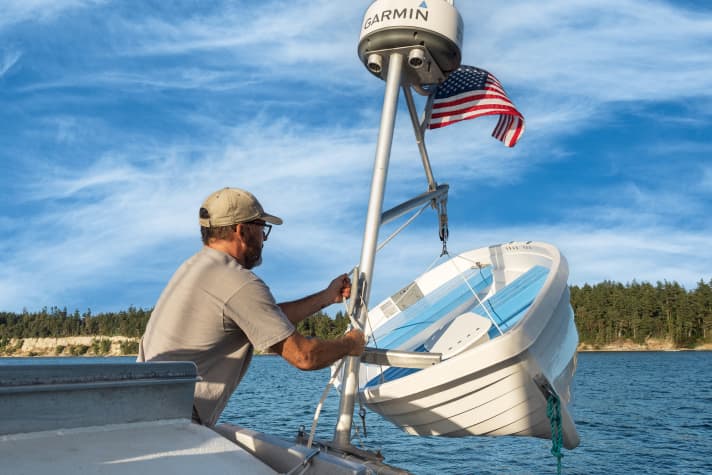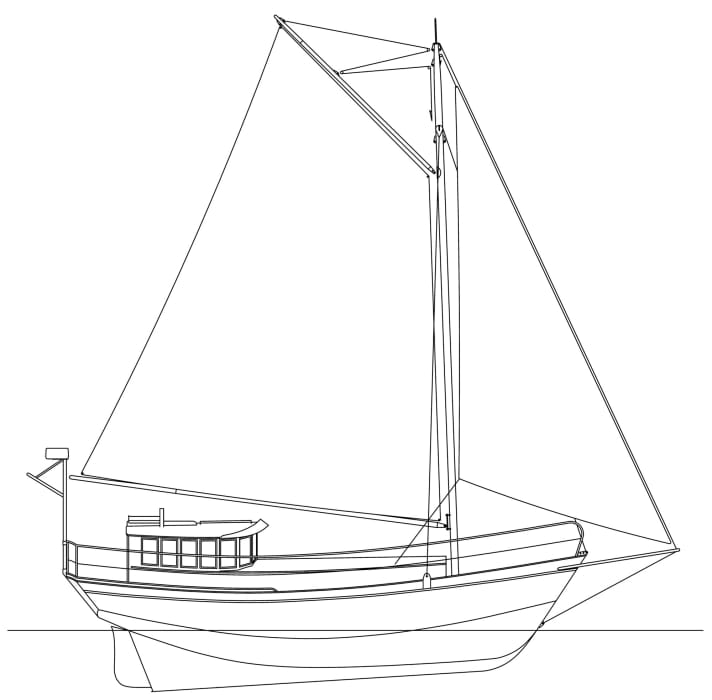





With a foaming bow wave and reefed main, "Panope" rushes across Mystery Bay near Port Townsend in the US state of Washington. The cutter looks huge, almost menacing from the frog's-eye view of the accompanying boat, which is actually quite astonishing considering the hull is only ten metres long. There is no need for a crew, as the ship is designed for solo operation. Only the ship's owner, Steve Goodwin, 54, is on board, lounging casually in the pushpit with neither a hand on the wheel nor the autopilot in operation. He doesn't have to, because "Panope", with her bent aluminium hull and long keel, sails all by itself. Without rudder pressure, as if on rails.
"She runs like a goods train on the cross," enthuses Goodwin about the boat that he has known and sailed since he was a child. "From ten knots of wind, when the leeward bulwark goes under water, there's music in it," he continues. According to Goodwin, the cutter sails best on a beam reach in medium winds. He only has to reef from wind force six. And if it blows harder, the jib is enough, but even then "Panope" practically steers itself.
She sails without rudder pressure, as if on rails. And on the cross she sails like a goods train. She's at her best when travelling on the beam"
Cutter rig instead of schooner rig
This balanced sailing behaviour is also due to the cutter rig, which replaced the old schooner rig and gave the ship a different look and better sailing characteristics. Goodwin moved the mast further forward to replace the old foremast and later installed a folding bowsprit, to which a good used jib of 17 square metres is attached, allowing the sail and lateral pressure point to be better balanced.
Reduced weight, no overhangs that drive up mooring fees, simple operation and lower maintenance are further advantages of this rig. A practical and unusual feature is the diagonal shackle at the foot of the solid aluminium mast, which can be practically laid by one person in just a few minutes using a jib pole.
The "Panope" is a robust aluminium yacht
The hull design is a Saugeen Witch, drawn by Thomas E. Colvin, whose designs were popular with enthusiasts of heavy, stable and ocean-going cruising boats. These are not designed for performance, but for stability and versatility, which is why there is no standardised rigging. Goodwin's father Lynn, 83, a retired marine biologist, ordered "Panope" in the seventies as a gaff schooner from the now closed Greenwich shipyard in Vancouver, Canada, and actually wanted to go on a long voyage with it.
As a fly fisherman who grew up far from the ocean in conservative Idaho, boats were primarily a means to an end for him. He had no idea about sailing, but a friend persuaded him to order a Saugeen Witch made of aluminium with a wall thickness of just under five millimetres, unfinished, for 13,000 US dollars. "He told me: 'You don't need an engine', but that was a mistake," says Lynn, who subsequently had a 15 hp Yanmar diesel installed. He fitted the oak and cedar interior himself, as he enjoyed woodworking. The boat was launched in 1981 - with the help of a house haulier. "We took the boat fishing, caught crabs and shrimps, sailed north to Barkley Sound on Vancouver Island and once to Cabo San Lucas in Mexico," remembers Goodwin senior. "In Cabo, we could moor for free in the harbour and there were chickens running around everywhere in the streets."
His profession as a marine biologist also gave "Panope" its name. In the 1960s, Lynn Goodwin was instrumental in researching the distribution of the elephant trunk or king conch in the Pacific Northwest. Its scientific name is Panopea generosa, but it is also known as the penis clam because of its shape. These marine animals are now farmed on a large scale for export to Asia, where they are considered a delicacy and an alleged aphrodisiac.
Son Steve turns the "Panope" upside down- and is still working on it today
At some point, Father Lynn found sailing and "Panope's" maintenance too arduous, but especially the 900-mile cross from Cabo to San Diego on the way north no longer appealed to him. At the time, he had the boat trucked back to Port Townsend, and the day eventually came when she was to be sold. However, his son Steve wanted to keep the ship in the family, became the new owner and significantly redesigned it for use as a coastal cruiser.
Work began at the turn of the millennium. And it is still ongoing today. Since then, winter has been the time for racking, summer the time for sailing, because "Panope" remained operational even during the renovation.
Goodwin junior is a multidisciplinary, talented autodidact who has acquired many manual skills as a boat builder, yacht crewman, builder's polisher and metal artist. He masters welding, carpentry and electrics in his sleep. He also works as a systems specialist at the Cape George shipyard, where he is also allowed to do one or two jobs for his refit of "Panope". However, Goodwin is not only a boat builder, he also built two houses and an aeroplane, even though he couldn't fly at the time.
As soon as he had his commercial pilot's licence in his pocket, he founded Goodwin Aviation, his own aviation company, with which he organised sightseeing flights in a biplane and transported particularly urgent passengers to Seattle International Airport by taxi plane. In order to remain flexible with his boat project, which was running on the side, Goodwin welded a single-axle trailer that is so precisely balanced that he only needs a small truck to trailer the seven-tonne "Panope" from winter storage at his house to the workshop and marina.
Firstly, he replaced the small diesel engine that his father had retrofitted with a 40 hp model, which was better suited for use in the tidal waters and rapids of the Inside Passage. The next project was a radical intervention, both visually and functionally: Goodwin sacrificed the "Panopes" cockpit for a deckhouse, which he welded together from aluminium and which extended the aft cabin superstructure. Up to six people can be accommodated on two longitudinal benches, completely protected from the weather, but with all-round visibility through large windows.
"Panope" can fall dry with a ten-degree incline
Goodwin installed the original wooden steering wheel, which his father carpentered and which moves the cables to the helm quadrant, on the port side of the companionway, with a recess for the spoke handles. He didn't "design the deckhouse for survival," Goodwin explains. Rather, the purpose of the boat was coastal sailing in higher latitudes, where it can be cold and rainy in the anchor bays of the fjords, even in summer. So comfort was the key. With her long keel and the almost 1.7 metre long aluminium prop for falling dry, "Panope" would also cut a fine figure on the mudflats. If necessary, Goodwin bolts this support into one of the unused aft jib fittings left over from the schooner rig. In this way, the boat stands on the beach at an angle of around ten degrees, which not only improves comfort on board but also allows maintenance work to be carried out on the underwater hull.

"Bigger on the inside than on the outside" is a phrase used to describe the space available in compact cars, but in a figurative sense it also applies to the cosy "Panopes" cabin. From the steep companionway stairs to the self-designed and built composting toilet in the bow compartment, which neatly separates urine and faeces and prevents unpleasant odours, the living space is mainly in red cedar and oak wood and has a completely open design. Only half-height bulkheads or frame bulkheads separate the galley, saloon and sleeping area from each other. This results in an airy and friendly ambience, but there is virtually no privacy. Up to six people can sleep here, but four would be ideal for longer trips. The saloon benches can be converted into berths in a few simple steps, and those on the starboard side can be converted into a bunk bed with a bunk board for a free watch during night cruises.
Another practical feature is the design of the stable and variable coffee table, which can be locked in any position thanks to a multi-dimensional and robust swivel arm and can therefore be used as a desk, dining table or even a workbench.
The tender hangs on a one-armed davit
Since the conversion, there is also plenty of easily accessible storage space under the berths, in the bow, at the side in the engine room or in the stern area. "We have up to four watercraft with us on a cruise and nobody notices," laughs Goodwin. There is a stand-up paddleboard, an inflatable boat, a tandem kayak (all inflatable and correspondingly compact to stow) and the Walker Bay plastic tender, which hangs from a single-arm davit that can be swivelled forward 180 degrees in the harbour together with the dinghy to shorten the overall length and save on mooring costs.

Despite all the extra weight and fuss on board, he was also concerned about the sailing characteristics. So, with some effort, he removed most of the old concrete ballast and several lead bars from the bilge to accommodate more weight further forward so that "Panope" would float on an even keel. He quickly poured the lead bars into their new shape using a temporary furnace to fit them exactly into the recesses in the bilge and sealed them with epoxy and fibreglass so that they would not come into contact with the aluminium plates of the hull. "Panope's" ballast is largely free of concrete, positioned more forward and lower, much to the benefit of the sailing characteristics.
Goodwin even welded aluminium deck plates that direct stray water into a drainage well, from where it is automatically pumped overboard. Another example is the anchor locker, which, like the anchor bracket and the manual winch on the foredeck, is meticulously planned and manufactured so that the chain falls cleanly into its container. This is more or less a point of honour, as Goodwin runs an informative YouTube channel for fun, on which he tests the holding power of anchors under tension on various surfaces. He initially used "Panope" for this until he bought an open skiff with an outboard motor for this purpose.
Goodwin's working methods are unorthodox, but the results speak for themselves
A self-diagnosed perfectionist, Goodwin also wanted to achieve a clean finish for the plywood surfaces in the cabin without using a spray gun. He first sealed the grain with epoxy or clear varnish and then flooded the wood, which lay flat on the worktable, with colour. To shorten the drying time, he also built a temporary drying chamber. Like much of the project, this process is somewhat unorthodox, but the result ultimately justifies the means.
"Panope" is not a delicate diva, but more of a work boat, with strong fittings and practical details that make her safe and easy to handle.
The fact that the cutter also has a strikingly charming exterior is a credit to the owner, who has worked skilfully and carefully. "I had the feeling that the forward rig took some of the visual impact away from the superstructure and that the deck looked tidier," explains Goodwin at the end of the sailing day. "I'm happy, some things are just nicer and more practical," he adds, casting off the lines and chugging back to his idyllic anchorage in Mystery Bay.
There he can enjoy the peace and quiet and plan the next construction site on the boat that his father bought almost half a century ago and named after a curious giant clam.
"Panope"- more workboat than yacht
What looks successful today is the result of brute boat-building force. Videos show Goodwin using a sledgehammer to demolish the old interior fittings (made by his father, after all) and tearing out everything down to the insulating foam in order to realise his ideas of comfort at sea. But that was by no means all. The aft ship was given a deckhouse, and Goodwin can steer from the inside and outside with the same wheel. The self-taught sailor replaced the original schooner rigging with a gaff rig without a bowsprit in order to save harbour dues and achieve a tidier deck with fewer controls. A single-arm davit, a wading prop, a new engine and various fittings welded from aluminium were also added. This and more can be seen on the YouTube channel of the busy hobbyist:
Technical data "Panope"

- Type: Saugeen Witch
- Design engineer: Thomas E. Colvin
- Material: Aluminium
- Torso length:10,36 m
- Waterline length:8,30 m
- Width:3,02 m
- Depth: 1,35 m
- Weight:6,8 t
- sail area: 61,8 m²
- Sail carrying capacity: 4,1
- machine (Yanmar): 40 HP

